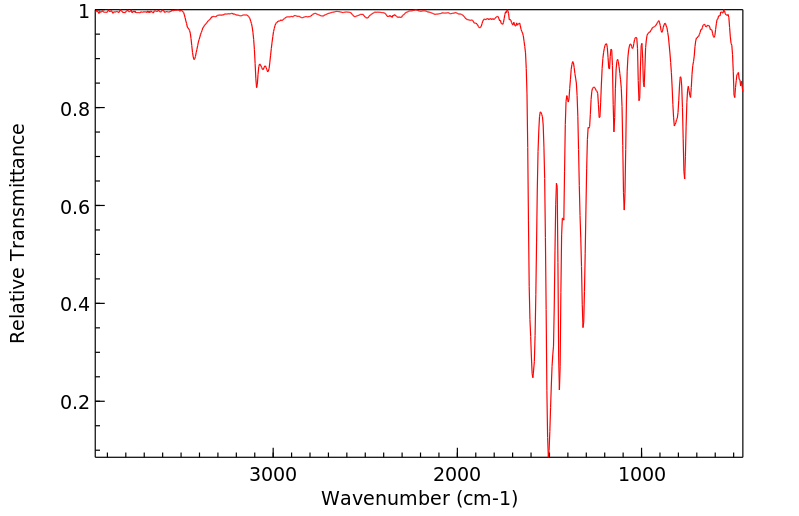N-(4-chlorophenyl)-2-aminopyridine | 22681-77-2
中文名称
——
中文别名
——
英文名称
N-(4-chlorophenyl)-2-aminopyridine
英文别名
N-(4-chlorophenyl)pyridin-2-amine;Pyridine, 2-(p-chloroanilino)-
CAS
22681-77-2
化学式
C11H9ClN2
mdl
MFCD01143314
分子量
204.659
InChiKey
PRZYJLBEQGBXQQ-UHFFFAOYSA-N
BEILSTEIN
——
EINECS
——
-
物化性质
-
计算性质
-
ADMET
-
安全信息
-
SDS
-
制备方法与用途
-
上下游信息
-
文献信息
-
表征谱图
-
同类化合物
-
相关功能分类
-
相关结构分类
物化性质
-
熔点:116 °C
-
沸点:130-135 °C(Press: 0.15 Torr)
-
密度:1.273±0.06 g/cm3(Predicted)
计算性质
-
辛醇/水分配系数(LogP):3.4
-
重原子数:14
-
可旋转键数:2
-
环数:2.0
-
sp3杂化的碳原子比例:0.0
-
拓扑面积:24.9
-
氢给体数:1
-
氢受体数:2
安全信息
-
海关编码:2933399090
SDS
上下游信息
-
下游产品
中文名称 英文名称 CAS号 化学式 分子量 —— N-(4-chlorophenyl)-N-methyl-2-aminopyridine 1383232-16-3 C12H11ClN2 218.686
反应信息
-
作为反应物:描述:N-(4-chlorophenyl)-2-aminopyridine 在 四丁基碘化铵 作用下, 以 甲醇 、 乙腈 为溶剂, 反应 10.0h, 以67%的产率得到1,2-bis(4-chlorophenyl)-1,2-di(pyridin-2-yl)hydrazine参考文献:名称:脱氢脱芳香化使氮中心自由基的可调电化学CN与NN键形成:生物应用。摘要:本文报道了一种环境友好的电化学方法,该方法利用俘获作用和离域作用产生氮中心自由基(NCR)。通过改变电极材料的反应参数和原料溶解度,脱芳香化使选择性脱氢的CN与NN键形成反应成为可能。因此,吡啶[1,2- a ]苯并咪唑和四芳基肼构架是通过具有广泛普遍性的可持续的无过渡金属和外源氧化剂的策略制备的。生物活性测定表明,吡啶并[1,2- a ]苯并咪唑类化合物具有抗微生物活性和对人类癌细胞的细胞毒性。化合物21具有良好的光化学性质,具有大的斯托克斯位移(约130 nm),并成功应用于亚细胞成像。初步的机理研究和密度泛函理论(DFT)计算揭示了可能的反应途径。DOI:10.1002/anie.202001510
-
作为产物:描述:N-(4-chlorophenyl)-N-pyridin-2-ylformamide 在 盐酸 作用下, 以 四氢呋喃 、 水 为溶剂, 以81 mg的产率得到N-(4-chlorophenyl)-2-aminopyridine参考文献:名称:2-Aminopyridines via Reaction of Pyridine N-Oxides and Activated Isocyanides摘要:A practical and efficient method for the synthesis of substituted 2-aminopyridines from pyridine N-oxides is reported. Yields of purified, isolated products of up to 84% are observed for the one-pot, two-step process. The reaction involves an in situ deprotection of an isolable N-formylaminopyridine intermediate and facilitates the synthesis of 2-aminopyridines for which other methods fail.DOI:10.1021/jo402693s
文献信息
-
Cu-Catalyzed Couplings of Heteroaryl Primary Amines and (Hetero)aryl Bromides with 6-Hydroxypicolinamide Ligands作者:David J. Bernhardson、Daniel W. Widlicka、Robert A. SingerDOI:10.1021/acs.oprd.9b00195日期:2019.8.16chemoselectivity and rate. The use of K2CO3 as the base enabled selective C–N coupling of aryl bromides over aryl chlorides with 2–5 mol % Cu at 80–120 °C. With K3PO4 as the base, aryl chlorides are capable of undergoing C–N coupling, though 5–10 mol % Cu is required at 120–130 °C. Members of the ligand family are straightforward to prepare in one step from 6-hydroxypicolinic acid and the corresponding
-
Iridium(III)-Catalyzed Tandem Annulation of Pyridine-Substituted Anilines and α-Cl Ketones for Obtaining 2-Arylindoles作者:Xin-Feng Cui、Xin Qiao、He-Song Wang、Guo-Sheng HuangDOI:10.1021/acs.joc.0c01619日期:2020.11.6readily available N-(2-pyridyl)anilines and commercially available α-Cl ketones through iridium-catalyzed C–H activation and cyclization is reported here. As a complementary approach to the conventional strategies for indole synthesis, the transformation exhibits powerful reactivity, tolerates a large number of functional groups, and proceeds with good to excellent yields under mild conditions, providing
-
Direct C–H alkylation and indole formation of anilines with diazo compounds under rhodium catalysis作者:Neeraj Kumar Mishra、Miji Choi、Hyeim Jo、Yongguk Oh、Satyasheel Sharma、Sang Hoon Han、Taejoo Jeong、Sangil Han、Seok-Yong Lee、In Su KimDOI:10.1039/c5cc07767b日期:——The rhodium(III)-catalyzed direct functionalization of aniline C-H bonds with [small alpha]-diazo compounds is described. These transformations provide the facile construction of ortho-alkylated anilines with diazo malonates or highly substituted indoles with...
-
Iridium-Catalysed Cascade Synthesis of Oxindoles Using Diazo Compounds: A Quick Entry to C-7-Functionalized Oxindoles作者:Ujjwal Karmakar、Debapratim Das、Rajarshi SamantaDOI:10.1002/ejoc.201700214日期:2017.5.18A cascade iridium-catalysed oxindole synthesis was achieved using pyridyl-protected anilines and bis(2,2,2-trifluoroethyl) 2-diazomalonate. The developed protocol is simple and scalable, and has a broad scope and excellent regioselectivity. The pyridyl directing group can easily be removed. The method was further extended to give C-7-functionalized oxindole derivatives in a straightforward manner.
-
On the Importance of an Acid Additive in the Synthesis of Pyrido[1,2‐ <i>a</i> ]benzimidazoles by Direct Copper‐Catalyzed Amination作者:Kye‐Simeon Masters、Tom R. M. Rauws、Ashok K. Yadav、Wouter A. Herrebout、Benjamin Van der Veken、Bert U. W. MaesDOI:10.1002/chem.201100574日期:2011.5.278‐substituted pyrido[1,2‐a]benzimidazoles (4) has been developed by a direct intramolecular CH amination of N‐phenylpyridin‐2‐amines (3). Efficient CH amination of 3 could only be achieved in the presence of catalytic copper and an acid additive. The type of acid (pKa) proved to be crucial for the catalysis. CCl aminations in N‐(2‐chloroaryl)pyridin‐2‐amines allow access to 9‐substituted pyrido[1,2‐a]benzimidazoles
表征谱图
-
氢谱1HNMR
-
质谱MS
-
碳谱13CNMR
-
红外IR
-
拉曼Raman
-
峰位数据
-
峰位匹配
-
表征信息
同类化合物
(βS)-β-氨基-4-(4-羟基苯氧基)-3,5-二碘苯甲丙醇
(S,S)-邻甲苯基-DIPAMP
(S)-(-)-7'-〔4(S)-(苄基)恶唑-2-基]-7-二(3,5-二-叔丁基苯基)膦基-2,2',3,3'-四氢-1,1-螺二氢茚
(S)-盐酸沙丁胺醇
(S)-3-(叔丁基)-4-(2,6-二甲氧基苯基)-2,3-二氢苯并[d][1,3]氧磷杂环戊二烯
(S)-2,2'-双[双(3,5-三氟甲基苯基)膦基]-4,4',6,6'-四甲氧基联苯
(S)-1-[3,5-双(三氟甲基)苯基]-3-[1-(二甲基氨基)-3-甲基丁烷-2-基]硫脲
(R)富马酸托特罗定
(R)-(-)-盐酸尼古地平
(R)-(-)-4,12-双(二苯基膦基)[2.2]对环芳烷(1,5环辛二烯)铑(I)四氟硼酸盐
(R)-(+)-7-双(3,5-二叔丁基苯基)膦基7''-[((6-甲基吡啶-2-基甲基)氨基]-2,2'',3,3''-四氢-1,1''-螺双茚满
(R)-(+)-7-双(3,5-二叔丁基苯基)膦基7''-[(4-叔丁基吡啶-2-基甲基)氨基]-2,2'',3,3''-四氢-1,1''-螺双茚满
(R)-(+)-7-双(3,5-二叔丁基苯基)膦基7''-[(3-甲基吡啶-2-基甲基)氨基]-2,2'',3,3''-四氢-1,1''-螺双茚满
(R)-(+)-4,7-双(3,5-二-叔丁基苯基)膦基-7“-[(吡啶-2-基甲基)氨基]-2,2”,3,3'-四氢1,1'-螺二茚满
(R)-3-(叔丁基)-4-(2,6-二苯氧基苯基)-2,3-二氢苯并[d][1,3]氧杂磷杂环戊烯
(R)-2-[((二苯基膦基)甲基]吡咯烷
(R)-1-[3,5-双(三氟甲基)苯基]-3-[1-(二甲基氨基)-3-甲基丁烷-2-基]硫脲
(N-(4-甲氧基苯基)-N-甲基-3-(1-哌啶基)丙-2-烯酰胺)
(5-溴-2-羟基苯基)-4-氯苯甲酮
(5-溴-2-氯苯基)(4-羟基苯基)甲酮
(5-氧代-3-苯基-2,5-二氢-1,2,3,4-oxatriazol-3-鎓)
(4S,5R)-4-甲基-5-苯基-1,2,3-氧代噻唑烷-2,2-二氧化物-3-羧酸叔丁酯
(4S,4''S)-2,2''-亚环戊基双[4,5-二氢-4-(苯甲基)恶唑]
(4-溴苯基)-[2-氟-4-[6-[甲基(丙-2-烯基)氨基]己氧基]苯基]甲酮
(4-丁氧基苯甲基)三苯基溴化磷
(3aR,8aR)-(-)-4,4,8,8-四(3,5-二甲基苯基)四氢-2,2-二甲基-6-苯基-1,3-二氧戊环[4,5-e]二恶唑磷
(3aR,6aS)-5-氧代六氢环戊基[c]吡咯-2(1H)-羧酸酯
(2Z)-3-[[(4-氯苯基)氨基]-2-氰基丙烯酸乙酯
(2S,3S,5S)-5-(叔丁氧基甲酰氨基)-2-(N-5-噻唑基-甲氧羰基)氨基-1,6-二苯基-3-羟基己烷
(2S,2''S,3S,3''S)-3,3''-二叔丁基-4,4''-双(2,6-二甲氧基苯基)-2,2'',3,3''-四氢-2,2''-联苯并[d][1,3]氧杂磷杂戊环
(2S)-(-)-2-{[[[[3,5-双(氟代甲基)苯基]氨基]硫代甲基]氨基}-N-(二苯基甲基)-N,3,3-三甲基丁酰胺
(2S)-2-[[[[[((1S,2S)-2-氨基环己基]氨基]硫代甲基]氨基]-N-(二苯甲基)-N,3,3-三甲基丁酰胺
(2S)-2-[[[[[[((1R,2R)-2-氨基环己基]氨基]硫代甲基]氨基]-N-(二苯甲基)-N,3,3-三甲基丁酰胺
(2-硝基苯基)磷酸三酰胺
(2,6-二氯苯基)乙酰氯
(2,3-二甲氧基-5-甲基苯基)硼酸
(1S,2S,3S,5S)-5-叠氮基-3-(苯基甲氧基)-2-[(苯基甲氧基)甲基]环戊醇
(1S,2S,3R,5R)-2-(苄氧基)甲基-6-氧杂双环[3.1.0]己-3-醇
(1-(4-氟苯基)环丙基)甲胺盐酸盐
(1-(3-溴苯基)环丁基)甲胺盐酸盐
(1-(2-氯苯基)环丁基)甲胺盐酸盐
(1-(2-氟苯基)环丙基)甲胺盐酸盐
(1-(2,6-二氟苯基)环丙基)甲胺盐酸盐
(-)-去甲基西布曲明
龙蒿油
龙胆酸钠
龙胆酸叔丁酯
龙胆酸
龙胆紫-d6
龙胆紫







